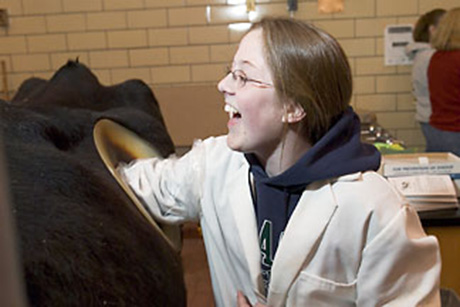Expanding Your Horizons '05 reaches out to middle school girls
By Media Relations Office

"Fishy Business," "Itty Bitty Pictures" and "Plants Can Breathe" have one thing in common: they were a few of the many hands-on workshops at Expanding Your Horizons (EYH), an annual conference at Cornell University that encourages girls in grades 7 to 9 to explore careers in science and technology.
This year's conference on April 23 attracted more than 200 girls from upstate New York middle schools. From 30 hands-on workshops on topics ranging from nanotechnology to plant sciences, each student selected three hour-long sessions, which were prepared and presented by Cornell female undergraduate and graduate students to stimulate interest in science.
The "Holey Cow" workshop, for example, focused on balanced hay diets and the stomach compartments in a dairy cow. The main attraction, however, was Daisy, a 13-year-old Holstein who has a special opening in the largest compartment of her stomach, called the rumen fistula, allowing researchers to take an inside peek and study her metabolism. In the workshop, the girls had a chance to do the same thing as well as put their hands inside Daisy's stomach.
"Girls who come usually have an interest in veterinary science, and they generally like the workshop because it is very hands on," said Kelly Smith, a graduate student in the Department of Animal Science who ran the popular event for the third year in a row.
While exploring the rumen sounds fun, it was, in fact, a steamy and smelly adventure. The offensive smell came from Daisy's methane gas, a byproduct of the millions of ruminant bacteria that are responsible for breaking down hay. Despite the odor, most girls were eager to don lab coats and latex gloves and excited to touch and feel the bumpy inside surface and damp rumen interior, which they described as "pretty warm and wet."
An important job for the student volunteers was to relate their own experiences as female scientists. Smith, for example, told the girls about her goal to work as a scientist in the dairy industry and the importance of having a graduate degree. "Animal science is one area of study that people usually don't think about, and I want to open the girls to possibilities in science," said Smith. "I want to give them a positive influence when there is so much negative press about animal diseases and food science."
Some girls came with their parents, but many were paired up with buddies -- female student volunteers who could serve as role models to inspire the young girls to excel in science. Including buddies and workshop helpers, the EYH conference was organized and run by more than 300 student volunteers, with help from the Cornell Center for Materials Research outreach office. "EYH would not happen without the volunteers," said Karen Masters, a doctoral student in astronomy and a co-chair of the conference.
Many of the girls and their parents praised the enthusiasm of the EYH workshop helpers. "It really opened my eyes to what I could really do when I get older ... the workshops were a lot of fun," wrote one girl on a conference evaluation from last year. Parents noted that EYH was "a wonderful mother-daughter experience" and "a gift to the girls in the community."
In addition to the student workshops, the conference hosted a panel discussion for parents by five women scientists, who described their experiences, and a keynote speech by Mary Lanzerotti, Cornell M.S. '94, Cornell Ph.D. '97, of the IBM T.J. Watson Research Center.
Media Contact
Get Cornell news delivered right to your inbox.
Subscribe